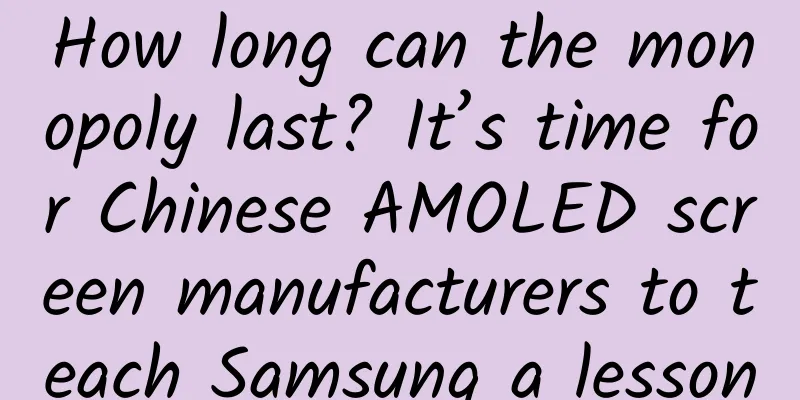How long can the monopoly last? It’s time for Chinese AMOLED screen manufacturers to teach Samsung a lesson

|
ZTE recently released a folding smartphone that has not been seen for a long time: Axon M. It sounds very sci-fi, but the appearance of this machine is hard not to remind people of something else: 3DS. It’s not entirely ZTE’s fault that the folding screen is like this. After all, flexible screens are not something you can use whenever you want. Last year, the total global shipment of flexible AMOLED was only 60 million units (CINNO Research). What does this mean? Samsung S7 edge, which was launched in March 2016, sold 13.3 million units in the first half of the year (Strategy Analytics), which accounted for more than one-fifth of last year's flexible screen shipments. The sales figures of S7 edge in 2016 were not clearly given, but according to data from Strategy Analytics, by May 2017, the combined sales of S7 and S7 edge exceeded 55 million units, of which 7.2 million were sold in the first quarter of 2017. Even if the sales of the straight-screen version of S7 are subtracted, there is still little supply of flexible AMOLED left for other manufacturers. In fact, Samsung has always maintained a near-monopoly position in the entire AMOLED screen market, not only in flexible AMOLED, but also in the entire AMOLED screen market. It has also restricted the supply quantity for many years. It was not until the Samsung Note 7 explosion incident that Samsung began to ship a large number of flat and curved AMOLED screens. This has also led to the frequent emergence of manufacturers with limited production capacity due to Samsung screen problems in recent years, from OnePlus 3/3T, Huawei Mate 9 Pro, to OPPO R9S/K, all of which are Samsung's "victims" Samsung's monopoly in the AMOLED market is so high that even LG Display, also a Korean panel manufacturer, cannot compete with it. Xiaomi Note 2 is a typical example. It is said that its dual-curved screen was originally planned to use Samsung screens, but was inexplicably abandoned, so it had to be replaced with LG Display. As a result, it attracted widespread criticism from users due to its poor display effect. Data shows that by the end of last year, Samsung alone accounted for 99% of the AMOLED market. It is no exaggeration to say that Samsung represents AMOLED, especially flexible AMOLED. The huge market and huge gap have made domestic panel manufacturers eager to build flexible AMOLED production lines. However, as of now, there is only one domestic panel manufacturer that can supply flexible AMOLED in large quantities. The first company to achieve supply was Kunshan Visionox (Guoxian Broadcasting), which is not often in the news. At the end of September, Kunshan Visionox announced that its flexible AMOLED full-screen products were off the assembly line, and officially launched the supply plan to the downstream smartphone industry chain. The meritorious company was the 5.5-generation line that just lit up the first flexible screen at the end of August. At the same time, at the end of August, Visionox's 6-generation line was successfully capped, and there is a high hope that production capacity will be further expanded in the next few years. I just don't know how much production there will be. Another company that is not in the news is Hehui Optoelectronics, which is making relatively slow progress. Although few people have heard of it, they have come a long way in rigid AMOLED. For example, the Redmi Pro and HTC One A9 both use hard AMOLED screens supplied by Hehui. As for flexible screens, Hehui is also working on them. At CES Asia in 2017, they exhibited their own flexible AMOLED samples. According to the plan, Hehui Optoelectronics has started to build a 6th generation flexible AMOLED production line in Shanghai Jinshan Industrial Zone at the end of last year, and it is expected to start mass production in 2019. Manufacturers that are always in the news are also not slow to act. For example, Tianma, a well-known screen manufacturer (due to the Redmi Note 2 screen replacement incident), publicly displayed its own flexible AMOLED samples as early as 2016. As for actual production, in April this year, Tianma successfully lit up a 6th generation line that produces both rigid and flexible AMOLED screens. It is believed that large-scale supply is only a matter of time. Speaking of flexible AMOLED companies that are often in the news, Royole said that compared to being second, no one would claim to be first. This company can be said to have been born with a halo: a young scientist who graduated from a prestigious university returned to China to start a business with the great idea of leaving a contribution to the world, and finally produced a brilliant answer sheet after hard work. The founder's brilliant background and the competitive investment of various institutions made this start-up company particularly dazzling. In 2014, Royole Technology successfully developed a flexible AMOLED screen with a thickness of only 0.01 mm, which was claimed to be the world's thinnest and lightest. It caused a sensation and made many media exclaim that it was just around the corner for domestic manufacturers to break Samsung's monopoly. But doubts soon emerged. The flexible screens displayed by Royole Technology always focused on emphasizing how thin and flexible they were, but they kept silent about the most important parameters of the display, such as color gamut, refresh rate, lifespan, etc., which made people suspect that they were just "making false claims". Further questions were directed at their factory construction investment. To illustrate how expensive it is to build a flexible screen production line, a case study is BOE, which has invested in a 6th generation flexible AMOLED production line in Chengdu and Mianyang respectively, with an investment of up to RMB 46500000000. No need to count, it’s 46.5 billion. RMB. Each one. So how much money did Royole Technology raise? The total amount of D round financing and debt financing at the end of last month was approximately RMB 5.3 billion. Moreover, this round of financing was well before the construction of the "Class 6" line started at the end of 2015. Royole Technology said that the entire production line is expected to invest 10 billion yuan, with an annual output of 50 million pieces, and mass production is expected to start in 2017. Even if what Royole Technology said about a 10 billion yuan 6th-generation line is true, their first three rounds of financing were about 1.1 billion yuan, and adding the above 5.3 billion yuan, there is still a huge gap of 3.6 billion yuan. Where does the missing money come from? As for whether it can be mass-produced smoothly, we can wait and see in two months in 2017. Now let's temporarily turn our attention away from Royole and see how traditional panel manufacturers are making a fortune in silence. As for BOE, which is very famous for some reason, you have seen it above, right? 6th generation line, flexible screen, two lines. It’s great to have money. Data shows that the design capacity of the two lines is 48K per month, and the total annual capacity is more than one million. It is said that BOE has successfully started small-scale trial production of flexible AMOLED. In a video, we saw the samples produced by BOE, which are extremely light and thin, with normal display switching response, and no problem with hitting with a little force with fingers. I believe that the production capacity of these two lines should be released soon, alleviating the current dilemma of domestic mobile phone manufacturers who cannot get AMOLED. But while we are happy, domestic AMOLED also has problems that must be faced. Samsung's AMOLED display devices can dominate the market not only because it has the largest production capacity at present, but also because of its excellent display effect. As we said before, the Xiaomi Note2 made by LG Display, which also supplies curved AMOLED displays, has a screen that some consumers cannot accept. Whether the screen color is accurate and the color gamut is wide enough, these basic qualities of a screen cannot be discounted because of the flexible characteristics. In addition, the production line has just started production, and it is bound to go through a period of running-in. What is the initial yield rate and how consistent the screen is? This may be the most pressing challenge that BOE is currently facing. Fortunately, Samsung is also exploring some special categories, and domestic manufacturers are not far behind. When the S8 was first launched, there was a large-scale red screen/red spot problem. Because the problem area of each screen was different, Samsung could not even eliminate the red spot through unified software adjustment. In the end, it had to provide detailed color control settings in the system, allowing users to locate and adjust the color of the spots by themselves, which became a laughing stock for a while. Can domestic manufacturers challenge Samsung? We hope they can teach Samsung a lesson. At least mobile phones will be cheaper in the future. As a winner of Toutiao's Qingyun Plan and Baijiahao's Bai+ Plan, the 2019 Baidu Digital Author of the Year, the Baijiahao's Most Popular Author in the Technology Field, the 2019 Sogou Technology and Culture Author, and the 2021 Baijiahao Quarterly Influential Creator, he has won many awards, including the 2013 Sohu Best Industry Media Person, the 2015 China New Media Entrepreneurship Competition Beijing Third Place, the 2015 Guangmang Experience Award, the 2015 China New Media Entrepreneurship Competition Finals Third Place, and the 2018 Baidu Dynamic Annual Powerful Celebrity. |
Recommend
SEO secrets - self-study SEO zero-based knowledge introductory optimization tutorial
Learn SEO with zero basic knowledge and fun, deton...
A sophisticated method for building user portraits!
1. What is User Portrait ? According to the offic...
Should companies develop WeChat mini-programs?
Should companies develop WeChat mini-programs? Do...
Changle SEO Training: Analysis of the reasons for the sudden increase in the frequency of Baidu spider crawling and the non-inclusion of website pages
The sudden increase in the number of websites cra...
Top 10 marketing keywords in 2018!
Usually at the end of the year, there will be var...
This "magic seasoning" is used by Chinese people to stew meat, but foreigners like to use it as a drink
When the weather gets cold, we can't help but...
Analysis of Kuaishou information flow advertising and advertising optimization tips!
A complete analysis of the Kuaishou information f...
Romantic fireflies are actually very cruel
The silver candle lights up the cold painting scr...
Should financial management apps look at daily activity data?
I recently heard that the ratio of daily active u...
Foreign media predicts that Alibaba will acquire Sina Weibo within six months
[[152728]] Alibaba Group, which has been imitatin...
APP promotion case, 4 major tactics and strategies for APP promotion in iOS market
As a veteran who has been in the APP promotion in...
How much does it cost to attract investment for the Wujiaqu Hotel mini program?
How much does it cost to attract investment in th...
【Food Information】Food Recipe Tutorial Collection Document
【Food Information】Food recipe tutorial collection...
How to write a good advertising case analysis? Three simple steps to tell you
During the holidays, a reader asked me a question...









